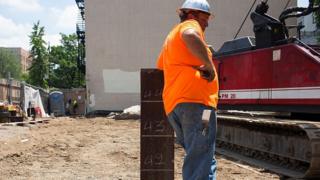 Picture copyright
Picture copyright
Getty Photos
The US economic climate additional far more work last month
The US unemployment charge fell sharply in August, as some corporations started to employ new team again and short term choosing for the US census boosted career figures.
Firms additional 1.4 million new positions and unemployment fell below 10% for the initial time considering the fact that the pandemic started.
It is the fourth thirty day period in a row that America’s employment photograph has enhanced, as the financial system commences to rebound from the depths of the coronavirus economic downturn.
Nonetheless, the unemployment amount is nonetheless considerably increased than it was in February.
In April, when lots of US states issued remain at household orders, the unemployment amount peaked at 14.7%.
Nevertheless, there are fears that the recovery in the labour current market is not sustainable.
The rate of jobs development is slowing. Stimulus payments and assist for compact enterprises have been exhausted. And negotiations in between the White Household and Congress over more stimulus continue to be stalled.
Neil Williams, senior financial adviser at Federated Hermes, said the unemployment figures had been getting ‘”significantly less awful” as furloughed employees return.
“But, even if work proceed to be clawed again at this rate, it would get a different nine months for the 12 million staff displaced given that February to return.
“The ‘under-employment’ rate, which consists of those not browsing, but seeking to work or work much more, continue to above 14%, might be even slower to fall. And as we know from 2007-09, swift occupation losses do not guarantee the sharpest recoveries.,” he extra.
More employment will will need to be extra if the US is to get employment back again to pre-coronavirus levels
Worse to appear?
The figures from the US Bureau of Labor Stats on Friday also showed regular hourly earnings improved .4%, also ahead of expectations.
On the other hand, Ian Shepherdson the chief economist at Pantheon Macroeconomics, suggests the August data may be skewed by governing administration using the services of of temporary census employees and “the worst may perhaps appear in September”.
“Personal sector career development in August was the slowest due to the fact the restoration began in May perhaps.
“At the August speed, it would consider 10 months for private sector work just to return to its February stage,” Mr Shepherdson claimed.
